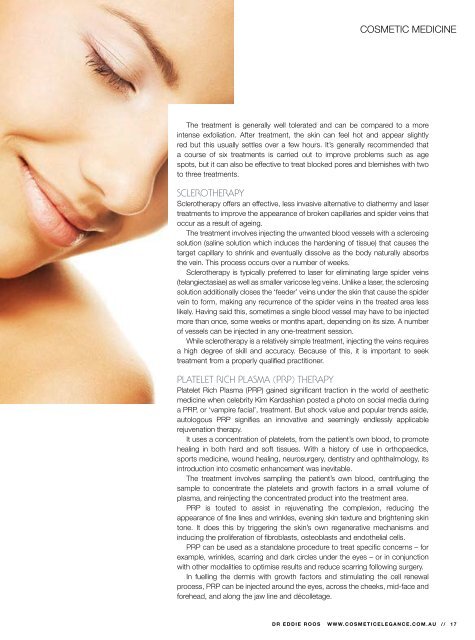You also want an ePaper? Increase the reach of your titles
YUMPU automatically turns print PDFs into web optimized ePapers that Google loves.
COSMETIC MEDICINE<br />
The treatment is generally well tolerated and can be compared to a more<br />
intense exfoliation. After treatment, the skin can feel hot and appear slightly<br />
red but this usually settles over a few hours. It’s generally recommended that<br />
a course of six treatments is carried out to improve problems such as age<br />
spots, but it can also be effective to treat blocked pores and blemishes with two<br />
to three treatments.<br />
SCLEROTHERAPY<br />
Sclerotherapy offers an effective, less invasive alternative to diathermy and laser<br />
treatments to improve the appearance of broken capillaries and spider veins that<br />
occur as a result of ageing.<br />
The treatment involves injecting the unwanted blood vessels with a sclerosing<br />
solution (saline solution which induces the hardening of tissue) that causes the<br />
target capillary to shrink and eventually dissolve as the body naturally absorbs<br />
the vein. This process occurs over a number of weeks.<br />
Sclerotherapy is typically preferred to laser for eliminating large spider veins<br />
(telangiectasiae) as well as smaller varicose leg veins. Unlike a laser, the sclerosing<br />
solution additionally closes the ‘feeder’ veins under the skin that cause the spider<br />
vein to form, making any recurrence of the spider veins in the treated area less<br />
likely. Having said this, sometimes a single blood vessel may have to be injected<br />
more than once, some weeks or months apart, depending on its size. A number<br />
of vessels can be injected in any one-treatment session.<br />
While sclerotherapy is a relatively simple treatment, injecting the veins requires<br />
a high degree of skill and accuracy. Because of this, it is important to seek<br />
treatment from a properly qualified practitioner.<br />
PLATELET RICH PLASMA (PRP) THERAPY<br />
Platelet Rich Plasma (PRP) gained significant traction in the world of aesthetic<br />
medicine when celebrity Kim Kardashian posted a photo on social media during<br />
a PRP, or ‘vampire facial’, treatment. But shock value and popular trends aside,<br />
autologous PRP signifies an innovative and seemingly endlessly applicable<br />
rejuvenation therapy.<br />
It uses a concentration of platelets, from the patient’s own blood, to promote<br />
healing in both hard and soft tissues. With a history of use in orthopaedics,<br />
sports medicine, wound healing, neurosurgery, dentistry and ophthalmology, its<br />
introduction into cosmetic enhancement was inevitable.<br />
The treatment involves sampling the patient’s own blood, centrifuging the<br />
sample to concentrate the platelets and growth factors in a small volume of<br />
plasma, and reinjecting the concentrated product into the treatment area.<br />
PRP is touted to assist in rejuvenating the complexion, reducing the<br />
appearance of fine lines and wrinkles, evening skin texture and brightening skin<br />
tone. It does this <strong>by</strong> triggering the skin’s own regenerative mechanisms and<br />
inducing the proliferation of fibroblasts, osteoblasts and endothelial cells.<br />
PRP can be used as a standalone procedure to treat specific concerns – for<br />
example, wrinkles, scarring and dark circles under the eyes – or in conjunction<br />
with other modalities to optimise results and reduce scarring following surgery.<br />
In fuelling the dermis with growth factors and stimulating the cell renewal<br />
process, PRP can be injected around the eyes, across the cheeks, mid-face and<br />
forehead, and along the jaw line and décolletage.<br />
DR EDDIE ROOS WWW.COSMETICELEGANCE.COM.AU // 17


















